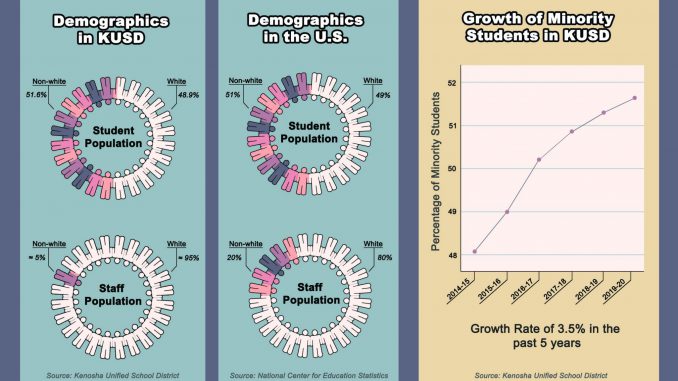
Written by Sohi Kang, Staff Writer

Each year, the student population of the Kenosha United School District becomes more diverse. From 2014 to 2019, the district experienced a 3.5 percent increase of non-white students — about 1,500 students.
Yet, while the percentage of non-white teachers continues to grow nationally, currently composing about 20 percent of the teacher population, at KUSD, ethnic and racial minority teachers make up about 5 percent of the staff.
Recently, in order to better represent the student population, a KUSD Diversity Recruitment Committee was created to better represent the student population and show the district’s commitment to diversity inclusion and equity.
Lindsey O’Connor, Chief Human Resource Officer of KUSD, said though committee members are just starting out, they are looking into different ways to recruit more minority teachers. Efforts include visiting historically black colleges or “Grow Your Own” programs that aim to cultivate diverse teachers within the community.
“There is research that shows that organizations that have a diverse employee population have more success in a number of different factors, including for employees feeling included, accepted and supported. And by extension that is what we would like the student body to also bene t from,” she said.
O’Connor said recruitment for diverse teachers will not negatively affect prospective teachers who are part of the nonminority.
“When we receive applications for positions, we don’t actually have access to their race or their gender. We focus on the minimum qualifications that are listed on the job posting and compare it to their application and resume and that is how candidates are called in for interviews,” she said.
Other organizations that have pushed for the inclusion of more minorities in the workplace include the Kenosha Education Association and the Coalition for Dismantling Racism.
Amanda Johnson, an English teacher at Indian Trail High School & Academy, worked with both of these organizations over the summer. She said that some students would come to her in the classroom with concerns about whether certain experiences with other teachers were racist and how to approach these situations. Working with the KEA, she had some of these students speak at the school board concerning these encounters.
“The first thing is helping the majority white staff to recognize their own biases,” Johnson said. “A lot of these are unconscious biases, and they might not even realize they have them. But they can be noticed or detected by students of color. You know, making assumptions about somebody because of their color or the tone of their voice or volume of their voice, things like that.”
Beginning in October, students have spoken at each school board meeting to advocate for the recruitment of more diverse teachers and plan on continuing to do so in the future. One such student who spoke was Delena King, a General Studies junior at ITA. As a
black student, she would not feel as motivated by her teachers as her peers do. “Nobody made me try. And I realized that a lot of other teachers, if there was a kid that didn’t do his homework the night before, the teacher would ask why. Whereas if I didn’t do the homework, it was ‘Oh okay, you just keep going, like, oh I guess it doesn’t matter,’” King said.
As to her motivations on speaking at the meeting, King said she wanted to do it because she feels more minority teachers are needed.
“Most of the school is (part of the) minority so if you see a reflection of yourself, it’s easier to feel like you can accomplish something,” she said.
Nashia Ogbuagu, a MedSci senior, also spoke at a KUSD board meeting about the dearth of diverse teachers.
“We feel like we’re not heard. We’re not taken seriously when we have issues; we’re just another lost cause,” Ogbuagu said.
Hiring more minority teachers can change that, she said.
“It’s important that I’m able to see success in an adult that I know that I can become. They understand where I’m coming from; they’re not picking on me because I’m different. What I noticed (is that) they’re more likely to understand you and not just see your outer appearances and go by that,” Ogbuagu said.
Joel Lopez, a General Studies sophomore, said he wished school officials had given him more time to speak at the meeting.
“Hopefully something happens, but looking at it, I don’t think nothing is going to change,” Lopez said. “Maybe if we have more people talk about this problem, there could be a change to it.”
This is not a new issue at KUSD. Tanya Kitts-Lewinski, a special education teacher and president of the Kenosha Education Association, said that in addition to repeated agreements for cultural competency training, there was an Office of Civil Rights complaint and agreement in 1997 and a diversity recruitment plan in 2012, which only lasted for certain periods of time.
“It’s not a new issue for KUSD. It was an important issue in 1997 and in 2012 and it continues to be an important issue today,” Kitts-Lewinski said.
